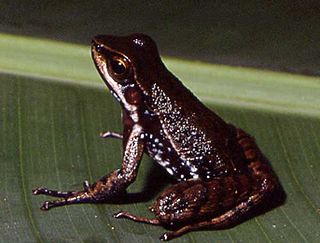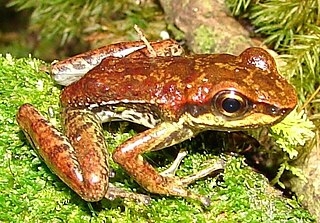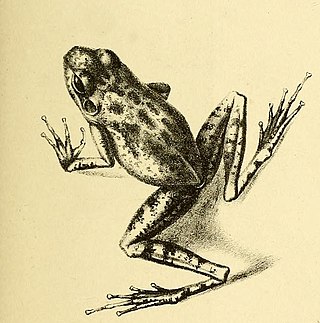
Paulo Emilio Vanzolini was a Brazilian scientist and music composer. He was best known for his samba compositions, including the famous "Ronda", "Volta por Cima", and "Boca da Noite", and for his scientific works in herpetology. He is considered one of the greatest samba composers from São Paulo. Until his death, he still conducted research at the University of São Paulo (USP).

Ranitomeya vanzolinii, also known as the Brazilian poison frog or spotted poison frog, is a species of frog in the Ranitomeya genus, from the poison dart frog family, Dendrobatidae. It is found in the Amazonian rainforests of Brazil and Perú, and possibly Bolivia.
Sphaenorhynchus platycephalus, commonly known as the South American lime treefrog or Lutz's lime treefrog, is a species of frog in the family Hylidae. It is endemic to south-eastern Brazil where it occurs in the Serra do Mar and Serra da Mantiqueira ranges in the states of Rio de Janeiro, São Paulo, and Minas Gerais. However, Araujo-Vieira and colleagues suggests that the Serra da Mantiqueira population could represent Sphaenorhynchus canga; the two species are similar.
Crossodactylus grandis, or the Bahia spinythumb frog, is a species of frog in the family Hylodidae. It is endemic to Brazil. Its natural habitats are subtropical or tropical high-altitude grassland and rivers. It is known solely from the Parque Nacional do Itatiaia in Minas Gerais in Brazil, where it lives in cloud forests. It is threatened by habitat loss.
Hylodes amnicola is a species of frog in the family Hylodidae. It is endemic to Minas Gerais in Brazil. It has been observed 1400 meters above sea level.

Hylodes is a genus of frogs in the family Hylodidae. The genus may be paraphyletic with respect to Megaelosia. The genus Hylodes is endemic to southeastern Brazil. Member species are also known commonly as the tree toads, or more ambiguously, as torrent frogs. They are diurnal and usually inhabit shallow mountain streams.

Hylodes asper, the warty tree toad or Brazilian torrent frog, is a species of frogs in the family Hylodidae. It is endemic to the Rio de Janeiro and São Paulo states in southeastern Brazil. Living in a high-noise environment, the species uses "semaphoring" to supplement acoustic signalling.
Hylodes babax or the Caparao Mountains tree toad is a species of frog in the family Hylodidae. It is endemic to Brazil.
Hylodes glaber or the Itatiaia tree toad is a species of frog in the family Hylodidae. It is endemic to Brazil and has been observed in and near Itatiaia. Its natural habitats are subtropical or tropical moist montane forest, subtropical or tropical high-altitude grassland, and rivers. It is threatened by habitat loss.

Hylodes heyeri is a species of frog in the family Hylodidae. It is endemic to Brazil. Its natural habitats are subtropical or tropical moist lowland forest, subtropical or tropical moist montane forest, rivers, and subterranean habitats on the Atlantic side of the country. It is threatened by habitat loss.
Hylodes lateristrigatus is a species of frog in the family Hylodidae. It is endemic to Brazil. Its natural habitats are subtropical or tropical moist lowland forest, subtropical or tropical moist montane forest, and rivers. It is threatened by habitat loss.

Hylodes meridionalis, also known as the Rio Grande tree toad, is a species of frog in the family Hylodidae. It is endemic to Brazil, in the states of Rio Grande do Sul and Santa Catarina. Its natural habitats are subtropical or tropical moist lowland forest and rivers. It is threatened by habitat loss stemming from deforestation, pine and banana plantations, and water pollution, as well as infection from the amphibian chytrid fungus, Batrachochytrium dendrobatidis.
Hylodes mertensi or Merten's tree toad is a species of frog in the family Hylodidae. It is endemic to Brazil. Its natural habitats are subtropical or tropical moist lowland forest and rivers. It is threatened by habitat loss.

Hylodes nasus is a species of frog in the family Hylodidae. It is endemic to Brazil. Its natural habitats are subtropical or tropical moist lowland forest and rivers. This frog has been observed 1400 meters above sea level.
Hylodes otavioi, Otavio's stream frog, or the Otavio tree toad is a species of frog in the family Hylodidae.

Hylodes phyllodes, or the Boraceia tree toad, is a species of frog in the family Hylodidae. It is endemic to Brazil. It has been observed in Serro do Mar in the state of São Paulo. Its natural habitats are subtropical or tropical moist lowland forest and rivers. It is threatened by habitat loss.
Hylodes regius, also known as the royal tree toad, is a species of frog in the family Hylodidae. The specific name regius is not explained in the original species description but probably refers to the yellow and purple-red markings in male Hylodes regius. It is endemic to the Itatiaia Mountains in Minas Gerais, Brazil. After more than three decades without observations, it was detected again in 2012.

Hylodes sazimai is a species of frog in the family Hylodidae. It is endemic to Brazil. Its natural habitats are subtropical or tropical moist lowland forest, subtropical or tropical moist montane forest, and rivers. It is threatened by habitat loss.
Hylodes uai is a species of frog in the family Hylodidae. It is endemic to the Espinhaço Mountains in the Minas Gerais state, Brazil, where it is known from the Mangabeiras Park in Belo Horizonte, and another location on the southern end of the Espinhaço Mountains. It is the most-inland species of the genus.
Hylodes perere is a species of frog in the family Hylodidae. It is endemic to Brazil and only known from Serra Negra, a part of Mantiqueira Mountains, in Santa Bárbara do Monte Verde, Minas Gerais state. The specific name perere is derived from a character in Indian folklore who guards the forest, disrupting its silence with its whistles—in reference to the vocalizations of this species.









